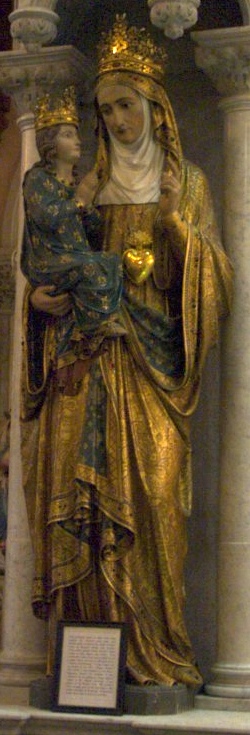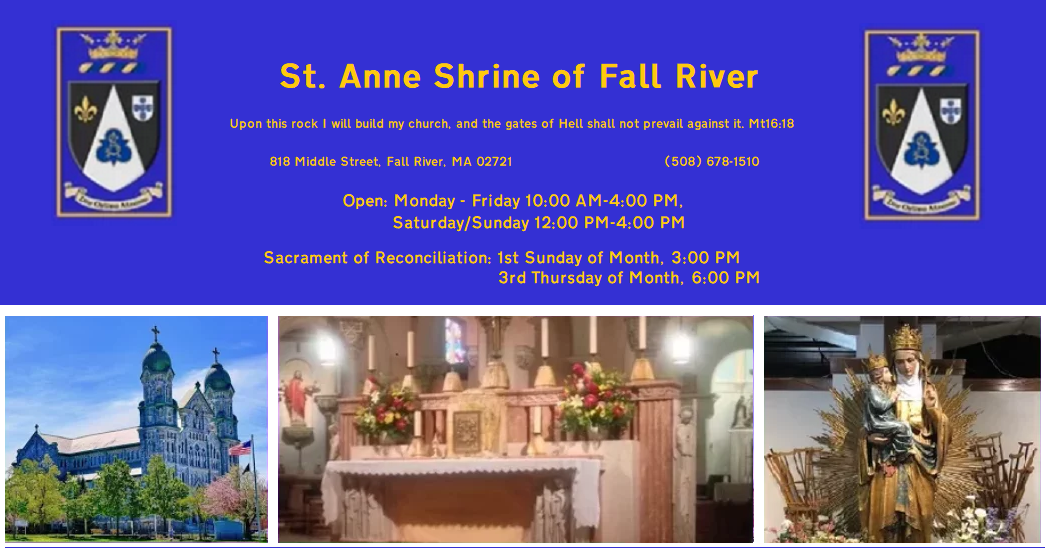In September 1869, a French priest came to form the first French-speaking parish of Fall River: Msgr Paul Romain Louis Adrien de Montaubricq, a French nobleman and an Honorary Canon of Bordeaux.

Briefly, he assisted Father Murphy at Saint Mary’s. Then he was authorized to form the new parish. They would use the Saint Mary’s facilities and he would live in the rectory. Quickly they would outgrow Saint Mary’s Church and the French priest would choose his own rectory. By the end of the year the new little parish had already found land to build its own church.
On 20 March 1870, the first church cornerstone is blessed. Tragedy struck on that day also producing what the newspapers called “probably the most serious accident that ever occurred in this city.”
As the ceremonies developed, the stage on which many of the parishioners had climbed suddenly collapsed: more than one hundred were injured, some thirty suffering fractures. Tradition says that in the midst of this sudden threat, the new pastor invoked Saint Anne for aid. No one died from the accident and Saint Anne was the name decided on for the new parish. Two months later, the church was open for worship.
A great mission was preached by the Oblate Fathers of Lowell to prepare all for the dedication on 13 December.
The new year 1871 started with a city-wide drive for aid in decorating the interior of the church. In January also the spirits of the parishioners were buoyed when a relic of Saint Anne was given to the parish thanks to the Apostolic Administrator of Quebec.
Fall River was then entering an era of great prosperity with some eleven mills opening in 1872. Soon, only two years after building the church, it was realized that the building was too small for the growing parish and additions had to be made to the Hunter Street church.
Saint Anne gave birth to its first parish in 1874 when the city was divided and a second Canadian parish was formed: Notre Dame de Lourdes in the Flint area of the city.
On 2 June, Father Montaubricq announced to his parishioners that his health did not permit him to continue the missionary pace he had been following. He decided to resign as pastor and return to France, though he did imply that he would return as soon as health permitted it. Later, he was to return sooner than expected and finding the parish under the new leadership of Father Briscoe, he moved to the Globe end of the city. When permission was denied him, at the bequest of Father Briscoe, to build a chapel in the Globe area (Shove Street) at his own expense, he returned to France never to return.
Rev. Thomas Briscoe
Father Briscoe, an assistant pastor at Saint Joseph Parish in the north end, had assisted Father Montaubricq before he resigned. Though he was not Canadian, he had a good knowledge of French thanks to his studies in France.
Much of his efforts at Saint Anne’s seemed to educational: he had the Jesus-Marie Sisters from the Flint teach Sunday school and evening classes; he built a convent on Granite Street and received the Sisters of the Holy Cross of Montreal.
For the laity, Father Briscoe founded many societies, among them: the Ladies of Saint Anne, the Third Order of Saint Francis, the Confraternity of the Blessed Sacrament.
During his tenure, more territory from the parish became a third Canadian parish: Saint Mathieu in the north end.
In June 1887, the desire to have a Canadian pastor increased an even gave birth to some difficulties. A 700-name petition was brought to the new Providence Ordinary, Bishop Matthew Harkins. A rumor began that a French-speaking religious order would be taking over the parish but this did not sit well with many.
In the fall, the Providence bishop confided his troubles to a classmate, Bishop Healy of Portland, Maine, and he invited the Dominicans at Lewiston to come to see Fall River.
Seeing that the Lewiston or Saint Hyacinthe officials were not able to accept the parish, the Bishop asked them to preach a long mission there, all the while testing whether they would eventually accept to minister to the Fall River Canadians. The project proved historical: the parishioners loved the French Dominicans and the Fathers loved the ministry.
